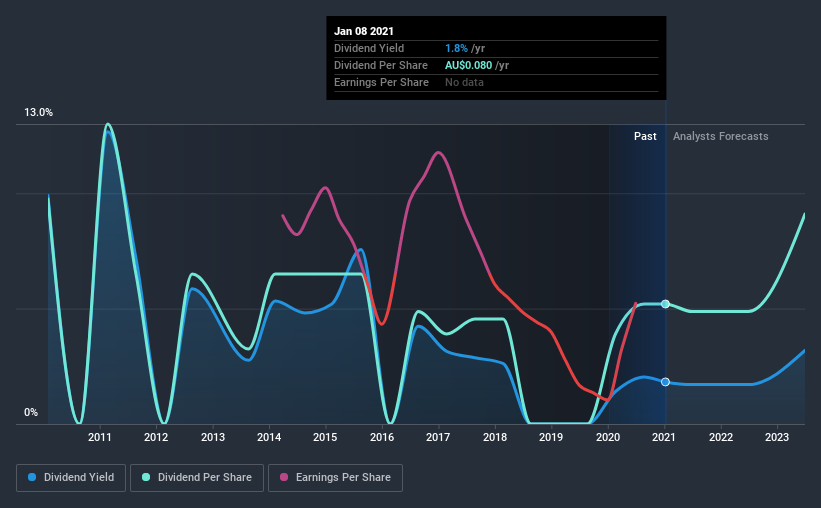- Australia
- /
- Diversified Financial
- /
- ASX:OBL
Does Omni Bridgeway Limited (ASX:OBL) Have A Place In Your Dividend Stock Portfolio?
Dividend paying stocks like Omni Bridgeway Limited (ASX:OBL) tend to be popular with investors, and for good reason - some research suggests a significant amount of all stock market returns come from reinvested dividends. If you are hoping to live on the income from dividends, it's important to be a lot more stringent with your investments than the average punter.
While Omni Bridgeway's 1.8% dividend yield is not the highest, we think its lengthy payment history is quite interesting. When buying stocks for their dividends, you should always run through the checks below, to see if the dividend looks sustainable.
Click the interactive chart for our full dividend analysis

Payout ratios
Dividends are typically paid from company earnings. If a company pays more in dividends than it earned, then the dividend might become unsustainable - hardly an ideal situation. As a result, we should always investigate whether a company can afford its dividend, measured as a percentage of a company's net income after tax. While Omni Bridgeway pays a dividend, it reported a loss over the last year. When a financial business is loss-making and pays a dividend, the dividend is not covered by profits. Its important that investors assess the quality of the company's assets and whether it can return to generating a positive income.
We update our data on Omni Bridgeway every 24 hours, so you can always get our latest analysis of its financial health, here.
Dividend Volatility
From the perspective of an income investor who wants to earn dividends for many years, there is not much point buying a stock if its dividend is regularly cut or is not reliable. For the purpose of this article, we only scrutinise the last decade of Omni Bridgeway's dividend payments. Its dividend payments have declined on at least one occasion over the past 10 years. During the past 10-year period, the first annual payment was AU$0.1 in 2011, compared to AU$0.08 last year. This works out to be a decline of approximately 6.1% per year over that time. Omni Bridgeway's dividend has been cut sharply at least once, so it hasn't fallen by 6.1% every year, but this is a decent approximation of the long term change.
We struggle to make a case for buying Omni Bridgeway for its dividend, given that payments have shrunk over the past 10 years.
Dividend Growth Potential
Given that dividend payments have been shrinking like a glacier in a warming world, we need to check if there are some bright spots on the horizon. Over the past five years, it looks as though Omni Bridgeway's EPS have declined at around 50% a year. With this kind of significant decline, we always wonder what has changed in the business. Dividends are about stability, and Omni Bridgeway's earnings per share, which support the dividend, have been anything but stable.
We'd also point out that Omni Bridgeway issued a meaningful number of new shares in the past year. Trying to grow the dividend when issuing new shares reminds us of the ancient Greek tale of Sisyphus - perpetually pushing a boulder uphill. Companies that consistently issue new shares are often suboptimal from a dividend perspective.
Conclusion
Dividend investors should always want to know if a) a company's dividends are affordable, b) if there is a track record of consistent payments, and c) if the dividend is capable of growing. We're a bit uncomfortable with it paying a dividend while reporting a loss over the past year. Earnings per share are down, and Omni Bridgeway's dividend has been cut at least once in the past, which is disappointing. Using these criteria, Omni Bridgeway looks suboptimal from a dividend investment perspective.
Investors generally tend to favour companies with a consistent, stable dividend policy as opposed to those operating an irregular one. At the same time, there are other factors our readers should be conscious of before pouring capital into a stock. For instance, we've picked out 1 warning sign for Omni Bridgeway that investors should take into consideration.
If you are a dividend investor, you might also want to look at our curated list of dividend stocks yielding above 3%.
If you decide to trade Omni Bridgeway, use the lowest-cost* platform that is rated #1 Overall by Barron’s, Interactive Brokers. Trade stocks, options, futures, forex, bonds and funds on 135 markets, all from a single integrated account. Promoted
New: AI Stock Screener & Alerts
Our new AI Stock Screener scans the market every day to uncover opportunities.
• Dividend Powerhouses (3%+ Yield)
• Undervalued Small Caps with Insider Buying
• High growth Tech and AI Companies
Or build your own from over 50 metrics.
This article by Simply Wall St is general in nature. It does not constitute a recommendation to buy or sell any stock, and does not take account of your objectives, or your financial situation. We aim to bring you long-term focused analysis driven by fundamental data. Note that our analysis may not factor in the latest price-sensitive company announcements or qualitative material. Simply Wall St has no position in any stocks mentioned.
*Interactive Brokers Rated Lowest Cost Broker by StockBrokers.com Annual Online Review 2020
Have feedback on this article? Concerned about the content? Get in touch with us directly. Alternatively, email editorial-team (at) simplywallst.com.
About ASX:OBL
Omni Bridgeway
Provides dispute and litigation finance services in Australia, the United States, Canada, Latin America, Asia, New Zealand, Europe, the Middle East, and Africa.
Excellent balance sheet and fair value.
Similar Companies
Market Insights
Community Narratives



